Plants of the family Solanaceae. Solanaceous
Solanaceous crops (lat. Solanoideae) - a family of spineolepidous dioecious plants. The family includes the subfamily Pasanova, consisting of 56 genera, but 115 genera and 2678 species belong to solanaceous cultures, most of which grow in the tropics and subtropics of America. For the first time, the properties of solanaceous crops were described in the work “The General History of New Spain Affairs” by Bernardino de Sahagun, which was compiled largely from the evidence of the Aboriginal people - the Aztecs. The Solanaceae family includes many edible plants, including those grown in culture, as well as medicinal and ornamental species, many of which are poisonous.
Family Solanaceum - description
The family members are herbaceous plants, shrubs and small trees with alternate or opposite (in the inflorescence area) leaves, bisexual actinomorphic or zygomorphic flowers, usually collected in axillary final inflorescences. Flowers of solanaceous cultures are pollinated by insects, in the tropics birds and even small mammals take part in pollination. The family is divided into two subfamilies - Solanaceae and Nolanovae. The Nolanova include the Nolan (75 plant species) and Alona (5-6 Chilean species) genera, and the Solanaceae subfamily consists of 5 tribes, and the most numerous of them is the Solanova tribe, which in turn is divided into subtribes. On the representatives of the tribe Solanaceae subfamily Solanaceous family Solanaceae and will be discussed in our article.
Solanaceae Plants
Tomatoes.
Tomatoes, or tomatoes (lat. Solanum lycopersicum) - This is a species of herbaceous annuals of the kind of nightshade of the family Solanaceae, cultivated as a vegetable. The name "tomato" comes from Italian and means "golden apple" (pomo d "oro), and" tomato "is derived from the Aztec name of the plant" shitomatl ". As already mentioned, solanaceous cultures were cultivated by Indian tribes. In the middle of the XVI century Conquistadors brought tomatoes to Portugal and Spain, then he went to France and Italy, and then spread throughout Europe. At first, tomatoes that were considered poisonous were grown as an exotic wonder. Fruits of tomatoes in Europe did not have time to ripen. It was possible to achieve it only when growing a culture by seedlings and using the method of ripening.
Tomatoes have a developed and branched root system of the core type, extending one meter or more in depth, and 1.5-2.5 m wide. Tomatoes have a dangling or upright, branching, height from 30 cm to two or more meters . The leaves are dissected into large lobes, the flowers are yellow, small and inconspicuous, gathered in a racemes inflorescence. In each flower there are both male and female organs. The fruits of tomatoes are multi-succulent berries of a round or cylindrical shape. Fruit sizes can reach 800 grams or more, but the average weight is usually 50-100 g. Depending on the variety, the color may be light pink, bright pink, red, red-orange, crimson, light or bright yellow. Tomatoes have high taste, nutritional and dietary properties and contain sugars (glucose and fructose), proteins, organic acids, fiber, pectins, starch and minerals.

By type of growth, tomato varieties are deterministic and indeterministic, according to the ripening time - early, middle-ripening and late, according to the purpose, tomato varieties are divided into canteen, intended for canning or for juice production, and tomatoes are standard, non-trumpeted and potato-type.
Tomatoes are a light and heat-loving culture that does not tolerate high humidity, but requires abundant watering. They are grown in both open and protected ground. If you want to plant tomatoes at your summer cottage, choose an open, but sheltered from the wind and well-lit place on the south or south-west side. The optimum acidity of the soil for tomatoes is 6-7 pH. Tomatoes grow best on light soils. Onions, cabbage, zucchini, cucumbers, carrots, pumpkin, green manure are suitable as precursors to tomatoes, and after such crops as potatoes, peppers, eggplant, physalis and other solanaceous tomatoes can be grown only after three or four years. There are many varieties and hybrids of tomatoes. From early tomatoes, the popular varieties Bely filling, Sparkle, Watercolor, Supermodel, Eldorado, Katyusha, Skorospelka, Zoloto, Mazarini, Triumph, Apparently, invisible, Black Bunch, Puzata Khata, from middle-ripened - Labrador, Gigolo, High Color, Marusya, Samson , Raspberry miracle, greenhouse tomatoes Auria, Afalina, Grandma's Secret, Königsberg. From late-ripening tomatoes, varieties of Rio Grand, Titan, Phenice yellow, Finish, Citrus orchard, Cherry, Market Miracle and others are in demand.
Eggplant.
Eggplant, or nightshade (lat. Solanum melongena) is a type of herbaceous annuals of the kind Paslen. Only fruits are edible in this plant - in the botanical sense they are berries, but in culinary terms they are vegetables. The Russian name "eggplant" comes from the Turkish "patlydzhan" and from the Tajik "boklachon." In the wild, eggplants grew in South Asia, India and the Middle East - in these areas and now you can meet the distant ancestors of this plant. According to Sanskrit sources, eggplants were introduced into the culture about 1,500 years ago. In the 9th century, Arabs brought eggplants to Africa; they came to Europe in the 15th century, but eggplants were widely spread only in the 19th century.
A powerful root system of plants can penetrate one and a half meters deep, but most of the roots are located in the surface layer of the soil - no deeper than 40 cm. The stem of the eggplant is pubescent, round in cross section, sometimes with a violet tinge, as well as large, alternate, rough and pubescent leaves similar in shape to oak. The height of the stem of determinant varieties intended for open ground reaches from 50 to 150 cm, and the indeterminant varieties bred for cultivation in greenhouses are up to 3 m high. Oboepolyye, with a diameter of 2.5 to 5 cm, are single, but more often collected 2-7 pieces in the inflorescences of the half-umbrellas eggplant flowers open from July to September. Their color varies from light purple to dark purple, but there are varieties with white flowers. The fruit of eggplants is a round, cylindrical or pear-shaped berry with a glossy or matte surface, reaching a length of 70, with a diameter of 20 cm, and sometimes in a mass of 1 kg. Eating fruits are consumed immature, as soon as they become purple or dark purple in color. If you give the berry to ripen, it will become gray-green or brown-yellow, tasteless and coarse. However, there are varieties of eggplant with the fruits of white, green, yellow and even red. Small light brown seeds ripen in fruit in August-October.
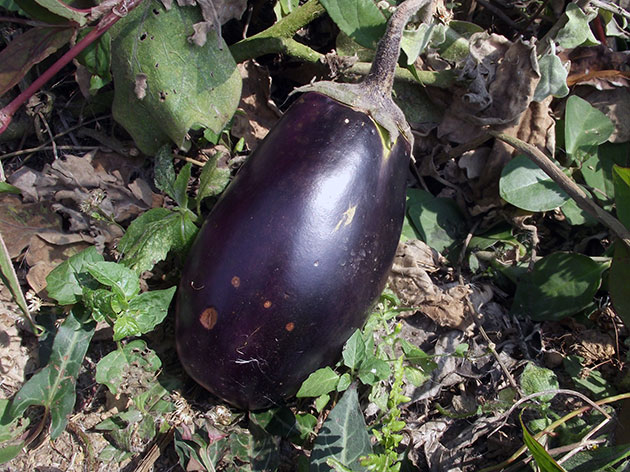
Eggplants are grown mainly by seedling. You should know that this culture is distinguished by increased demands on growing conditions: eggplants can throw off buds, flowers and even ovaries from fluctuating temperatures; seeds germinate at a temperature not lower than 15 ºC; the plant shows high sensitivity to light, therefore in cloudy weather, in the shade or in thickened plantings, the growth of eggplants slows down dramatically, and small fruits are formed; soil moisture in the bed with eggplants should be maintained at 80%. In addition, eggplant poorly tolerate transplant and pick.
Eggplants are grown in light, loose, well-fertilized sandy soil in open and sunlit areas. The best predecessors for eggplants are cucumber, winter wheat, onions, cabbage, siderata, carrots, pumpkin, zucchini, squash and legumes. The worst predecessors are other solanaceous, after which eggplant can be grown only after three to four years.
The composition of the ripe fruit of eggplants includes fiber, dietary fiber, carotene, pectin, organic acids, tannins, sugar, biologically active and mineral substances. Eating eggplants helps to improve the condition of the biliary tract, gastrointestinal tract, blood vessels and heart, increase hemoglobin, excretion of excess cholesterol.
Among the many eggplants, the most popular varieties can be distinguished: Swan, Black Handsome, Solaris, Maria, Vera, Japanese Dwarf, Globe, Bear, Diamond, Egorka, Northern, Lower Volga, Panther, Surprise, Long Purple, Albatross, Dark-skinned Woman, Golden Egg, White egg, Valentine, White night, Japanese red, hybrids Violet miracle, Emerald, Galina and Esaul.
Pepper.
It is a type of herbaceous annual plants of the Kapsikum genus of the family Solanaceae. Pepper is a valuable and widely cultivated agricultural crop. The varieties of this plant are divided into sweet (for example, Bulgarian pepper, or vegetable pepper, or paprika) and bitter (red pepper). However, you should be aware that the black pepper, belonging to the genus Pepper Pepper, does not have any peppers. The homeland of chilli pepper is America - where it is still found in the wild. In a culture, chilli pepper is grown in tropical, subtropical and southern temperate latitudes of all continents.
Actually, pepper is a perennial shrub, but in culture it is grown as an annual plant. The stem of the pepper is upright, strongly branched, 25 to 80 cm high. The leaves are petioled, elongated, pubescent or smooth — the leaves of bitter pepper are narrow and long, larger and wider in sweet. Bisexual small flowers of white, gray-violet or yellow shade are revealed 2.5-3 months after sowing. Pepper fruit is a two-six-dimensional multi-seeded berry. In sweet pepper, the fruits are large, fleshy, round, cylindrical or elongated; in hot peppers, small, elongated - styloid, horn-like or hoboid. The color of ripe fruit is red, yellow or orange. The seeds are round, flat, pale yellow in color.
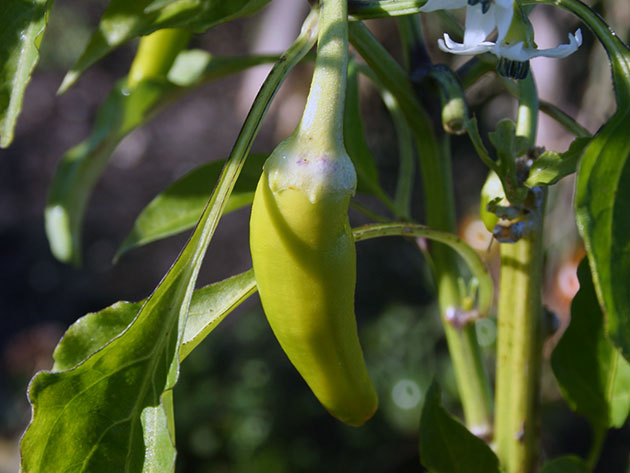
The main value of pepper lies in the high content of vitamin C, which is more in the pulp of the fruit of this plant than in lemon or black currant. Vitamins P, A and Group B, zinc, phosphorus, magnesium, iron, iodine, as well as sodium and potassium are part of the sweet pepper fruits, and to their taste and aroma, bell pepper is bound to capsaicin, an alkaloid useful for gastrointestinal activity.
Peppers are grown, as are eggplants, in a mainly rassadny way. The root system of the pepper is superficial - most of the roots are located at a depth of 20-30 cm. The areas set aside for pepper must be sunny and protected from the wind. Optimal for the plant is a fertile, well-drained soil capable of retaining moisture. The plot for pepper is prepared in the fall - cleaned of weeds and plant debris, dug up and fertilized. The best predecessors for chilli peppers are beets, carrots, turnips, rutabagas, daikon, radish, peas, beans, squash, zucchini, pumpkin, cucumbers, and after solanaceous cultures, peppers can only be grown after 3-4 years.
Among the best varieties of sweet pepper can be called such as Atlant, Red Spade, Big Papa, Bagheera, Gold Reserve, Apricot Favorite, Agapovsky, Bogatyr, Bugay, Cow's Ear, Health, Yellow Bell, California Miracle, Tusk, Fat Baron, Siberian Bonus , Kolobok, Kakadu, Gemini, Claudio, Gypsy, Eskimo, Star of the East (white, white in red, gold and chocolate), Isabella and others.
Among the varieties of bitter paprika, Adjika, Hungarian yellow, Vizier, Indian summer, Magic bouquet, Gorgon, Mother-in-law, Bully, Double abundance, Coral, White lightning, Fiery volcano, Fiery bouquet, Queen of Spades, Superchili, Teschin language and others are most popular .
Potatoes.
Potatoes, or tuberous nightshade (lat. Solanum tuberosum) - Perennial herb of the genus Solanus, the tubers of which are one of the main foods in many countries around the world. The scientific name of the plant was assigned in 1596 by Caspar Baugin, and the Germans named it potato, slightly remaking the Italian word tartufolo, which means “truffle”.
The birthplace of potatoes is South America, where it is still found in the wild. Potatoes were introduced into the culture 7-9 thousand years ago by Indians who lived in Bolivia - they not only ate, but also worshiped this culture. In Europe, the potato appeared, most likely, in 1551, and the first evidence of its use in food dates back to 1573. Then the culture spread to Belgium, Italy, France, the Netherlands, Germany and the UK as an ornamental poisonous plant, but Antoine Auguste Parmantier proved that potato tubers are tasty and nutritious, and this allowed him to win in France during his lifetime of scurvy, hunger, which often the population of the country suffered. In Russia, potatoes appeared under Peter I, but did not receive mass distribution. Due to the fact that the culture was strange for the people, the cases of poisoning with the fruits of the potato, which the peasants called “damn apple”, and when the order to increase the planting of potatoes came, “potato riots” swept through the country - people were afraid of innovations, and in this warmly supported by the Slavophiles. The “potato revolution” was crowned with success already in the time of Nicholas I, and by the beginning of the 20th century, potatoes had become the staple food in the Russian Empire after bread.
Today, potatoes are grown in the temperate climate zone of all countries of the Northern Hemisphere, and in 1995 it became the first vegetable to be grown in space.
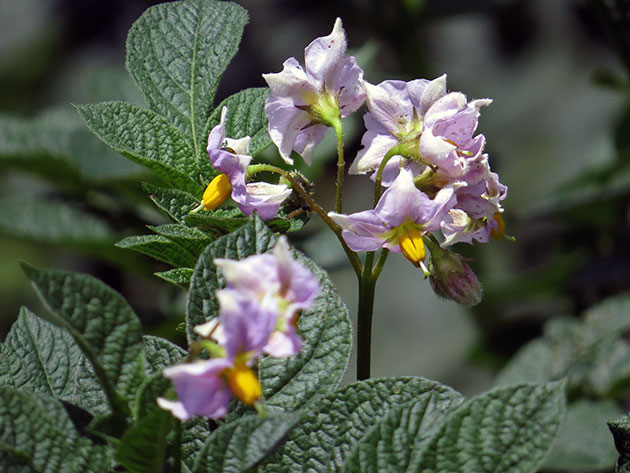
The potato bush can reach a height of one meter, the stem of the plant is bare and ribbed, the leaves are dark green, petiolate, non-paristorassaline, consisting of a finite lobe and several pairs of lateral lobes located oppositely. Between the lobes of the leaves are small slices. The flowers of the potato are pink, purple or white, collected in apical corymbose inflorescences. On the underground part of the stem, stolons grow from the rudimentary sinuses - underground shoots, on the tops of which tubers develop, representing swollen buds. Tubers consist of cells filled with starch, and outside they are covered with a thin cork cloth. Potato tubers ripen in August-September. The fruit of the potato is a dark green, seedy, poisonous berry resembling a tomato, up to 2 cm in diameter. The green organs of the potato contain solanine, which is poisonous to human alkaloids, and therefore tubers with proseleny cannot be eaten.
Potato tuber is 75% water, it also contains starch, proteins, sugars, fiber, pectins, other organic compounds and minerals. Potatoes have high nutritional value and are one of the main suppliers of potassium. It is boiled unpeeled and peeled, fried, stewed, baked on coals and in the oven. It is used as a side dish, added to salads, soups, it is made from independent dishes and chips.
Potatoes are grown on chernozem, in gray forest and sod-podzolic soils, on drained peatlands, in light and medium sandy loamy and loamy soils - the land for cultivation of the crop should be loose. There are about five thousand varieties of potatoes, which differ in terms of ripening, the degree of resistance to diseases and pests and yield. According to the purpose of using varieties of potatoes are divided into four groups - table, feed, technical and universal. Technical varieties of tubers produce starch, fodder varieties are high in protein and dry matter. Table varieties are grown as a vegetable crop, and universal in protein and starch content occupy an intermediate position between the technical and table varieties. The maturation grades are divided into superearly (Zhukovsky Early, Bellarosa, Coletta, Impala), Early (Vineta, Gala, Good Luck, Red Scarlett, Red Lady, Wizard, Bonus, Spring, Baron), Middle Early (Romano, Ivan-Da Marya, Blue Danube, Nevsky, Ilinsky, Handsome, Jelly), mid-season (Roco, Nakra, Blue, Aurora, Bonny, Batya, Donetsk, Dunyasha) and middle-late (Red Fantasy, Picasso, Zarnitsa, Garant, Mozart, Orbita, Malinovka, Marlene).
Melon pear.
Melon pear, or sweet cucumber, or pepino (lat. Solanum muricatum) - an evergreen shrub native to South America, which is grown for its sweet fruits, reminiscent of pumpkin, melon and cucumber. Cultivate the plant mainly in Chile, Peru and New Zealand.
Pepino is a perennial, semi-woody shrub with numerous axillary shoots, reaching a height of one and a half meters. In adverse conditions, the plant sheds leaves. The root system of a melon pear is fibrous and compact, lying shallow. Stems are erect, flexible, 6–7 cm in diameter, covered to a greater or lesser degree with anthocyanin, curved and thickened in the area of internodes. Aging stems become ashy gray. In conditions of high humidity the plant forms aerial roots. The leaves of pepino alternate, simple or divided into 3-7 lobes, lanceolate, entire, dark or light green, smooth or pubescent. Inflorescences of 20 or more flowers are formed at the end of the shoots, but the growth of arrows after disclosure of flowers continues - flower stalks reach a length of 4 to 20 cm. The color of the flowers can be monotonous - blue, white, light purple, and with blue stripes in the middle petals. The ripe fruit is a lemon yellow or creamy yellow berry, sometimes covered with purple specks or jagged strokes. The skin of the fruit is smooth, shiny and transparent. The shape of the fruit can be oblong, flat-rounded, flattened or reverse pear-shaped, weighing from 50 to 750 g, up to 17 in length and up to 12 cm wide. Melon pear pulp is juicy, fragrant and tender. The fruits of pepino, grown in temperate climates, are usually seedless, and fruits that have ripened in the tropics sometimes contain seeds, and sometimes they do not. Propagated melon pear seeds and cuttings.
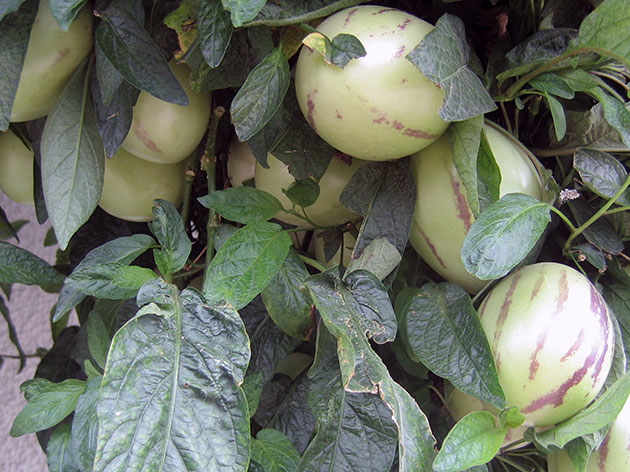
Pepino fruits have a high content of iron, carotene, vitamins B1, B2 and PP, reducing sugars and pectins.
In the middle lane, a melon pear is cultivated indoors, in a winter garden or in a heated greenhouse. In temperate climates, cultivars Ramses and Consuelo are grown.
Physalis
- the largest genus of the family Solanaceae. In the people it is called "ground cranberries" or "emerald berry." In the wild, most species of this genus grow in South and Central America. Physalis is an annual and perennial herb with woody at the bottom of the stem. A characteristic feature of the form is a cover-case made of paper, similar to a paper Chinese lantern, and a sepal fused around the fruit. As soon as the fruit is fully ripe, the cup dries out and changes color. In total, the genus Physalis includes 124 species, but only five of them are cultivated:
- - Physalis ordinary (Physalis alkekengi);
- - glutenopropyl physalis (Physalis ixocarpa);
- - Peruvian Physalis (Physalis peruviana);
- - Physalis vegetable (Physalis philadelphica);
- - physalis pubescent, or strawberry (Physalis pubescens).
Fruits of some types of Physalis are eaten - for example, Physalis vegetable, or gluten-fruit, or Mexican, which is more often called Mexican tomato or ground cherry. Its fruits resemble small tomatoes. There is also berry Physalis, the fruits of which have more modest dimensions than the fruits of Physalis vegetable, but they have a pleasant aroma and taste, similar to the taste of strawberries, pineapple and grapes. However, in the middle lane, Physalis is grown more often as ornamental plants for the sake of "Chinese lanterns", and vegetable and berry Physalis can be found only at the site of enthusiasts.
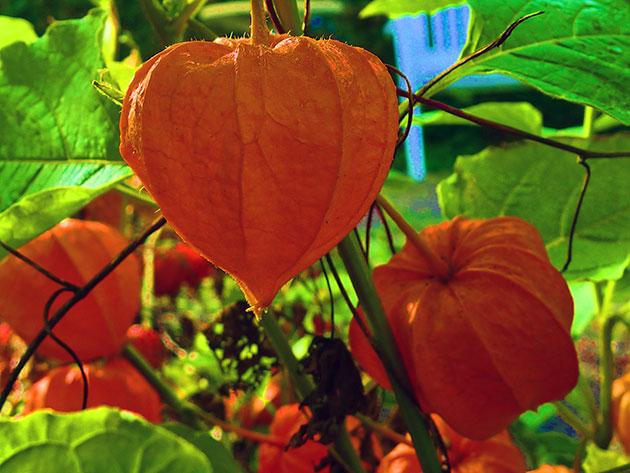
Physalis vulgaris, or Physalis Franche, or a Chinese lantern originally from Japan. In culture, the view from 1894. It is a decorative perennial, wintering in a temperate climate and withstanding temperatures down to -30 ºC. Every spring it grows back from the roots. The fruits of Physalis ordinary in a bright red-orange shell are spectacular, but inedible because of the bitter taste.
Physalis is grown in bright sun in fertile soil. The plant does not require formative trimming, but tall varieties should be tied up, and in order for the lanterns to mature before cold weather, at the end of summer you have to pinch the tops of the shoots of the plant. To physalis does not degenerate, once every 6-7 years old bush is divided and seated.
Cocoon.
Cocoon (lat. Solanum sessiliflorium) - fruit shrubs come from the Amazon region of South America. Today it is cultivated in Peru, Venezuela, Colombia, Brazil and other countries of this continent.
In nature, the cocoon is a grassy shrub up to 2 m in height with velvety oval leaves up to 45 m long and 38 cm wide and large oval fruits up to 4 m long and 6 cm wide. The unripe green cocoons are covered with fluff, but as they mature they become smooth and become yellow, red or purple. The skin of the fruit is bitter, beneath it is a dense layer of cream-colored pulp, and under the pulp is a jelly-like core with flat, small seeds.
In our climate, cocoon is grown in a greenhouse or on a windowsill.
In the culture you can also find such edible nightshade such as naranhilla, saraha and sunberry, but these are rare plants that are grown in temperate climates in room culture.
Nightshade bitter.
- A plant of the Nightshade family of the Solanaceae family, growing in the temperate and subtropical zones of the Old World in damp thickets of shrubs, willowy trees, along the banks of ponds, rivers, swamps and lakes. It is a perennial shrub up to 180 cm in height with a creeping rhizome, long, twisting, angular, climbing and branched stems, woody at the bottom, and alternate, pointed, oblong-ovate leaves with a heart-shaped or dicotyledonous base. Upper leaves can be dissected or tripartite. On long peduncles of nightshade, paniculate inflorescences are formed from regular bisexual flowers of lilac, pink or white color. The fruit of the nightshade is hung bright red shiny ellipsoidal berry up to 1 cm long.
Steroids and alkaloids are found in the roots of nightshade; terrestrial organs also contain alkaloids and steroids — cholesterol, stigmasterol, campesterol, sitosterol, and others. The composition of the leaves and seeds include triterpenoids, steroids, alkaloids, flavonoids, higher fatty and phenol carboxylic acids, contains steroids and flowers. Carotenoids beta-carotene, carotene, lycopene, sitosterol, steroids sitosterol, campesterol, stigmasterol and others are found in the fruits of the nightshade. The nightshade has bitter-sweet diuretic, choleretic, diuretic, laxative, sedative, expectorant and astringent properties.
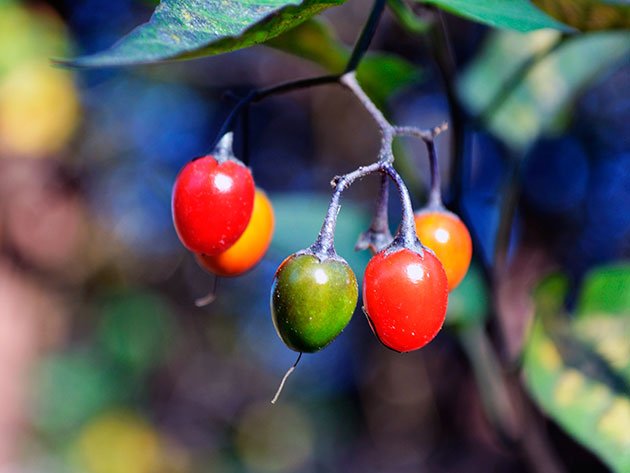
Nightshade bitter-sweet is an ornamental, medicinal, and also poisonous and insecticidal plant. A decoction of leaves of nightshade destroys the caterpillars and their larvae. In folk medicine for skin diseases - itchy inflammations and eczema - young shoots of the plant are used, they are also used for asthma, colds, cystitis, diarrhea and menstrual disorders. The leaves are used to treat pertussis, dropsy and jaundice, and externally - for rheumatism and scrofula. At the same time, flowering and fruiting nightshade has a high decorative effect and is used for vertical gardening in damp places.
Belladonna.
Belladonna, or belladonna common or beautiful or mad berry or cherry mad or european Belladonna, or belladonna belladonna (latin. atropa belladonna) is a herbaceous perennial, kind of Belle Belle family. Belladonna translated from Italian means "beautiful woman" - Italian ladies in olden time dripped into her eyes the belladonna juice to give them shine and expressiveness. Belladonna berries rubbed their cheeks, so that they acquired a natural tone of blush. A mad berry called belladonna for the fact that its constituent atropine brought the person into a state of strong excitement.
In the wild nature, belladonna is common in the hornbeam, oak, beech and fir forests of Europe, North Africa, the Caucasus, the Crimea, Asia Minor and the mountainous regions of Western Ukraine. Prefers a plant of forest fertile or light humus soils on the edges, clearings or along river banks. The plant is included in the Red Book of Ukraine (with the exception of the Ternopil and Lviv regions), Azerbaijan, Armenia and Russia.
In the first year of growth, the belladonna develops a branched taproot and stem, reaching a height of 60-90 cm, and from the second year the plant has a thickened rhizome with numerous branchy roots. Stems in belladonna green or dark purple, straight, branched, juicy, thick, with not very pronounced edges, up to 200 cm in height, strongly pubescent with glandular hairs in the upper part. Leaves are petiolate, dense, ovate, pointed and entire. The upper leaves are arranged in pairs, lower - alternately. The upper part of the leaf plate is green or brownish-green, the underside is lighter. Solitary or paired, drooping belladonna bell-shaped flowers emerge from the sinuses of the upper leaves. The color of the flowers is dirty purple or yellow, flowering begins in May and lasts until late autumn. The fruit of the belladonna is a brilliant, flat, bilocular, dark-violet, almost black berry, resembling a small cherry, in which there are many angular or bud-shaped seeds. Fruit ripening begins in July.
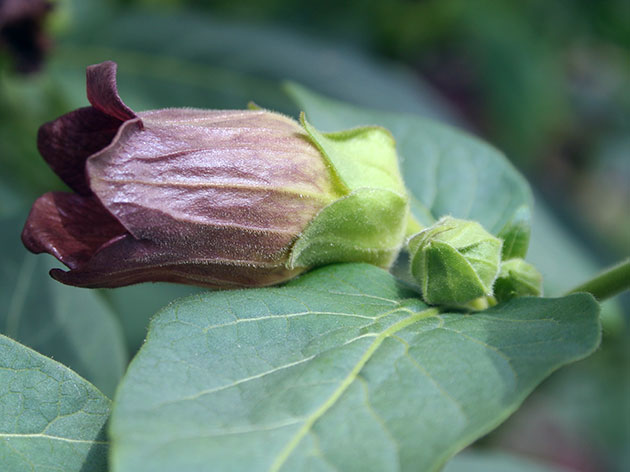
The terrestrial organs of the belladonna contain oxycoumarins and flavonoids. All parts of the plant are poisonous because they contain atropine alkaloids, which can cause severe poisoning. In addition to atropine, belladonna contains hyoscin, hyoscyamine, belladonnin, and other dangerous substances. The maximum content of alkaloids in the leaves is observed in the period of budding and flowering, and in all organs in the phase of seed formation. Belladonna make all kinds of drugs - candles, pills, drops ... Belladonna preparations are used for gastric ulcer and duodenal ulcer, spasms of smooth muscles of the abdominal cavity, renal and biliary colic, anal fissures, in the treatment of fundus vessels, bronchial asthma and other diseases . However, they should be taken only as prescribed by a doctor.
Signs of mild poisoning may appear for 10–20 minutes: dryness and burning appear in the mouth and throat, it becomes difficult to swallow, heartbeat quickens, the voice wheezes, the pupils dilate and stop responding to light, vision is disturbed, photophobia occurs, the skin becomes dry and redness, excitement, delusions and hallucinations. In severe poisoning there is a complete loss of orientation, there is a strong mental and motor arousal, you may experience cramps, shortness of breath, a sharp rise in temperature, blue mucous membranes, blood pressure drops and there is a threat of death from vascular insufficiency and paralysis of the respiratory center. At the first symptoms of belladonna poisoning, you need to call an ambulance.
The belladonna was introduced to the crop just for the sake of medicinal raw materials, the quality of which when grown on plantations is significantly higher than that of wild-growing belladonna. The plant has a long growing season - from 125 to 145 days, depending on growing conditions. Planted belladonna in low-lying areas with good humidity, provided that groundwater occurs at a depth of at least 2 m from the surface. The soil should be fertile, light or medium in texture, permeable to air and water. The best precursors for belladonna are vegetable, industrial and winter crops.
Henbane.
- herbaceous biennial, which in nature can be found in North Africa, in Malaya, Front and Central Asia, in the Caucasus, in China, India and almost all of Europe.
In height, the henbane reaches from 20 to 115 cm. It has an unpleasant smell, the plant is covered with a sticky fuzz. In the first year of growth, only a rosette of soft, pointed elliptical petioled leaves, notched-pinion-split or with large teeth is formed, and thick erect branchy stems appear the following year. The root of the plant with a thick root neck, vertical, branched and wrinkled, so soft that sometimes almost spongy. The leaves on the stems are alternate, sessile, oblong-lanceolate, notched or notched-lobed. The upper side of the leaf plate is dark green, the lower side is lighter, greyish. Rosette leaves at the time of formation of leaves on the stems die off. Sessile dirty yellow or whitish flowers with purple-violet inside the funnel-shaped corolla are located at the ends of the stems. Henbane blooms in June and July. The fruit is a two-cap box, resembling a jug in shape and closing with a hemispherical lid. In the box are numerous brown-gray or dark brown seeds of a rounded or reniform, slightly flattened form.
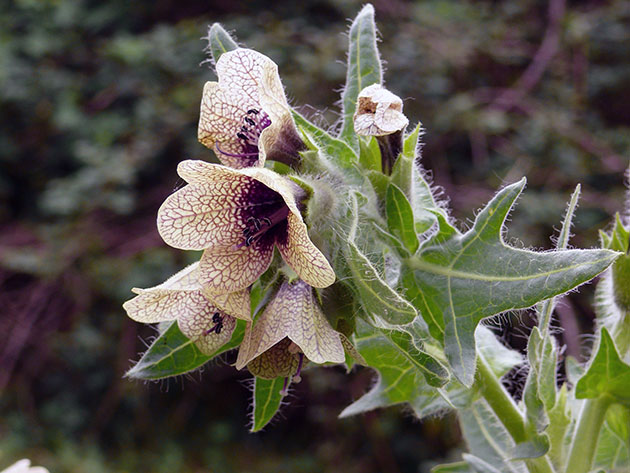
All parts of the henbane are poisonous because they contain potent alkaloids scopolamine, atropine, and hyoscyamine. In the seeds of the plant, up to 34% of a light yellow fatty oil is found, which contains oleic and linoleic acids, as well as unsaturated acids. In addition, henbane contains resinous and protein substances, gum, glycosides, sugar and mineral salts. Alkaloids of henbane have a spasmolytic effect on smooth muscles, increase intraocular pressure, dilate the pupils, suppress the secretion of the glands, increase heartbeat. Alkaloids have an effect on the central nervous system - scopolamine lowers its excitability, and hyoscyamine increases. Henbane preparations are used for gastric and duodenal ulcers, intestinal spasms, bronchial asthma, biliary tract diseases, neuralgia, a cold, cough, pleurisy. Aeron-based black henben tablets relieve a seizure of seasickness, they are also prescribed for its prevention. Henbane drugs are taken only on prescription. When poisoning bleached appear the same signs as in belladonna poisoning.
Blena is grown on fertile, loose, neutral soil. The best to sow it all over the black pair or after the winter crops that were sown over the black pair. Before sowing, black henbane seeds are stratified.
Dope
Datura ordinary, or stinky dope (lat. Datura stramonium) is a common plant in Europe belonging to the genus Datura (Datura). The Latin name for the dope was given to Karl Linnaeus in 1753, and it is translated from ancient Greek as “insane nightshade”, although there is an assumption that the specific epithet is derived from the French word stramoine and means “smelly weed”. In the Russian language, the following names were invented for the dope: foolish potion, diva-tree, bodyacon, stupefying grass, foolishness. For the first time an ordinary dope was described by Bernardino de Sahagun from the words of the Aztecs, who were well acquainted with his poisonous effect.
Datura is a grassy annual with a height of up to 1.5 m with a strong and branchy taproot, erect, bare, forked branching stems and petioles, alternate, whole, ovate, toothed leaves with a pointed apex. The upper side of the leaf plate is dark green, the lower side is lighter. Datura flowers are solitary, large, axillary or apical, white and stupefying fragrant, with a funnel-folded corolla. Flowering begins in June-August. The fruit of the dope ordinary - chetyrehgnezdnaya box with two wings, covered with spikes. As soon as numerous dull black reniform seeds ripen, the box cracks.

All plant organs are very poisonous due to the alkaloids contained in them daturins, which have an atropine-like effect. Particularly dangerous in this regard, the seeds of plants. However, the leaves, seeds and tops of the shoots of the dope ordinary are the raw material for the manufacture of medicines that have a calming effect on the central nervous system, as well as an antispasmodic and analgesic effect in diseases of the biliary tract, gastrointestinal tract and upper respiratory tract. It is necessary to take drugs of the dope ordinary only according to the doctor’s prescription, otherwise poisoning is possible, the symptoms of which we described in the section on belladonna.
They grow dope on loose, nutrient-rich soils fertilized with ashes. By growing conditions, the plant is unpretentious.
Mandrake.
- A genus of herbaceous perennials growing in Central and Western Asia, in the Himalayas and the Mediterranean. Mandragora is also called the witch root, Adam's head, sleepy potion and the devil's apple. Like many solanaceous crops, the mandrake is poisonous. Its root is vaguely reminiscent of a human figure, like the ginseng root, and therefore this plant is overgrown with legends attributing magical power to it. The leaves of the plant - large, short-petaled, whole, oval or lanceolate, marvelous, up to 80 cm long - are assembled into a socket with a diameter of 1-2 meters or more. Mandragora stalks do not form, and its dark brown outside and white inside the roots reach a length of one meter and contain a large amount of starch and tropane alkaloids - scopolamine and geoscyamine. Mandrake flowers are solitary, bell-shaped, up to 5 cm in diameter, purple, blue or white with green. The fruit of the plant is a yellow globular apple-flavored berry.
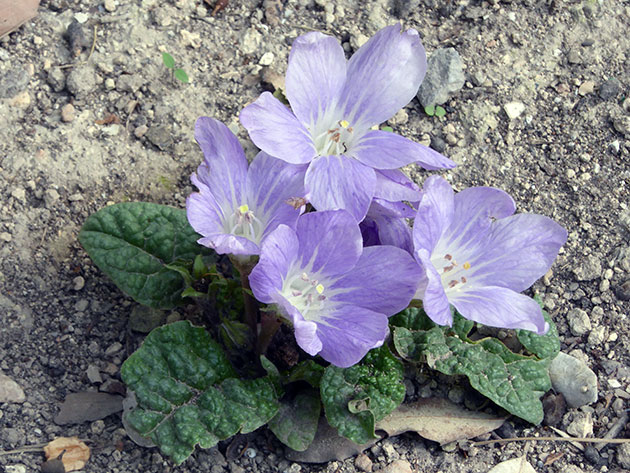
It is impossible to eat the fruits of mandrake because it can cause serious side effects and even death. In modern official medicine, mandragora and preparations from it are no longer used, but in traditional medicine the root of mandrago is still used: fresh juice - for rheumatism and gout, dried root - as an antispasmodic and painkiller for neuralgia and joint pain, and also for diseases of the gastrointestinal tract, and the freshly grated and mixed root with honey and milk is applied to tumors and edemas. In order to relieve pain in gout and rheumatism, mandrake oil mixed with fat is used for rubbing.
Tobacco.
It belongs to the genus of annual and perennial plants of the family Solanaceae. Until the 16th century, tobacco grew only in South and North America, but in 1556 tobacco seeds came from Brazil to France and they were germinated in the vicinity of Angouleme, and in 1560 tobacco was grown at the court of Philip II as an ornamental plant. Soon snuff tobacco became fashionable in Europe, and after 1565 the British spread the fashion for smoking. In 1612, in the English colony of Jamestown, the first harvest of virgin tobacco was grown. For several years, tobacco has become one of the main exports of the state of Virginia and was used by colonists as currency in barter. Today, this culture is grown in many countries, and dried leaves of certain species are used for smoking.
The root of tobacco is long, pivotal, reaching a length of two meters. Stem branched, rounded in cross-section, straight, leaf-stalked, large, whole and pointed, in many species with lionfish. Red, pink or white flowers are collected in corymbose or paniculate inflorescence. The fruit of tobacco is a multi-seeded box that cracks when ripe. Dark brown oval tobacco seeds are highly germinating.

Tobacco leaves contain antibacterial substances, so tobacco dust is often used to treat plants from diseases and pests. In folk medicine, there are many recipes from tobacco for the treatment of external and internal diseases: tincture of tobacco is used for cancer and scabies, with sap for treating sore throat and malaria. Cut tobacco leaves scare the mole.
Most often cultivated in the culture of broadleaf Maryland and virgin tobaccos, as well as ordinary shag. Girlish tobacco is less commonly cultivated. Tobacco is sown after black steam or after winter crops grown after black steam into loose soil - preferably black soil, loam, sandy loam or loamy-marl soil. You can not plant tobacco after beets and nightshade.
Decorative Solanaceae Plants
Brugmansia.
- genus of the family Solanaceae, isolated from the genus Datura. This includes shrubs and small trees. The most common in culture are Brugmansia tree, or woody, and Brugmansia snow-white, or woody dope, or angel trumpets. Both species are common in the tropics and subtropics of South America - in Brazil, Colombia, Chile, Ecuador, Argentina, Peru, the West Indies, and as a cultivated plant they are grown all over the world in greenhouses, in indoor conditions and in the open ground.
The lobular roots of Brugmancia form an expanding woody layer near the surface, but straight stem roots go deep, so when dividing the roots, part of the upper layer has to be chopped with an ax. The stems of Brugmansia are covered with bark, since in the subtropics the lignification of the land part occurs very quickly. The leaves of the plant are oval, barely pubescent, located on the petioles up to 13 cm long. The tubular drooping white, yellow or pink flowers up to 25 meters in diameter and up to 20 cm in diameter exude a intoxicating aroma, which is intensified towards evening. Brugmansia blooms twice in the subtropics: the first time in late August or early September, the second time in October or November. After the second flowering, the plant again forms the buds, but they no longer have time to open up and die.

In a temperate climate, Brugmancia is grown as an ornamental plant, and in Latin America it can be used to treat tumors, abscesses, asthma, rheumatism, arthrosis, and eye infections. Brugmansia snow-white Chilean, Colombian and Peruvian Indians used for medical purposes, and before Columbus its hallucinogenic properties were used for religious ceremonies.
You should know that Brugmansia, like most solanaceous crops, is poisonous.
Petunia.
- genus of semi-shrubs or herbaceous perennials of the family Solanaceae, reaching a height of 10 cm to 1 m. South America, in particular Brazil, is the birthplace of petunias. Under natural conditions, it can be found in Argentina, Bolivia, Paraguay and Uruguay, and only one type of plant grows in North America. According to different sources, there are from 15 to 40 plant species. In the culture of petunia from the XVIII century. Hybrid varieties of plants that appeared more than a hundred years ago, bred as garden, pot and balcony annuals. Petunia has become popular due to its large and bright flowers of various colors.
Stems in petunias are erect or creeping, forming second and third order shoots. Depending on the variety, they can reach a height of 30 to 70 cm. The shoots of petunia are green, round, pubescent with glandular pile. Leaves alternate, sessile, different in shape and size, entire and also pubescent. The flowers are most often large, solitary, simple or terry, with a funnel-shaped corolla, located on short pedicels in the axils of the leaves. Petunia fruit is a bivalve box that cracks when ripe and throws out small seeds.
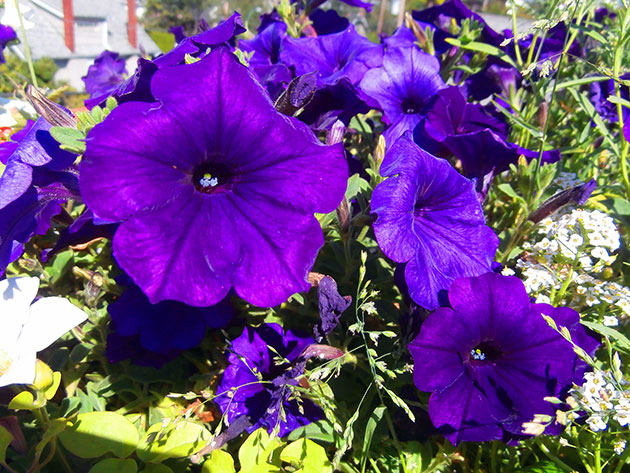
Petunia hybrid varieties are divided into four groups:
- - large-flowered petunias, in which the diameter of flowers reaches 10 cm;
- - multi-flowered petunias - plants with small flowers up to 5 cm in diameter;
- - Petunias are short, dwarf, from 15 to 30 cm high;
- - ampelous petunias, which include cascade petunias, calarachoa and surfinia.
Petunias are heat-loving and even drought-resistant plants, so they love sunny places, and in the shade their shoots stretch out, forming a large number of leaves and few flowers. The soil for the plant will require fertile - sandy or loamy. For the cultivation of petunias on the balcony is best to use a mixture of coarse river sand, peat, turf and hardwood in the ratio of 1: 1: 2: 2. Protect plants from wind and rain, which easily damage the delicate petunia flowers.
Sweet tobacco is also a solanaceous plant. It should be said that so called two types of tobacco - Sander tobacco (lat. Nicotiana x sanderae) and winged tobacco, or Athenian (lat. Nicotiana alata). In America, in natural conditions, fragrant tobacco is a perennial plant, in our climate it is cultivated as an annual. These are erect bushes with a height from 40 to 150 cm with large dark green leaves of elliptical shape and funnel-shaped star-shaped fragrant flowers of white, yellow or green color. There are hybrid varieties with carmine flowers, but they do not smell. Fragrant tobacco blossoms all summer. The fruit of the plant is a multi-seeded egg-shaped box with very small seeds that remain viable for up to 8 years.

Sweet tobacco is a thermophilic and light-loving plant that does not tolerate frost and prefers well-fertilized and moist loamy soils. The best varieties of plants are Winged, Night fire, Green light, Pleasure, Aroma Green, Maju Noir and Dolce Vita hybrids and Tinkling bell. Recently, low-growing hybrids of fragrant tobacco for growing on window-sills and balconies, characterized by long and abundant flowering, have begun to appear.
Nightshade decorative.
Or coral bush or cuban cherry - A species of Nightshade, which grows in South America and has spread to other areas with a warm climate. In Australia, this species of nightshade has become a weed.
False nightshade is an evergreen shrub in height from 30 to 150 cm with smooth stems, short-stemmed, slightly wavy lanceolate leaves up to 10 cm long and small white single flowers or gathered in a brush. The fruit is a red or yellow berry with a diameter of 1.5-2 cm. The ornamental shrub becomes at the stage of fruit ripening: from light green they turn yellow, then orange and finally bright red. Ripening occurs throughout the winter, and bright berries among the green leaves look very impressive.
Dwarf forms of nightshade Nana and Tom Tum are very popular in room culture.
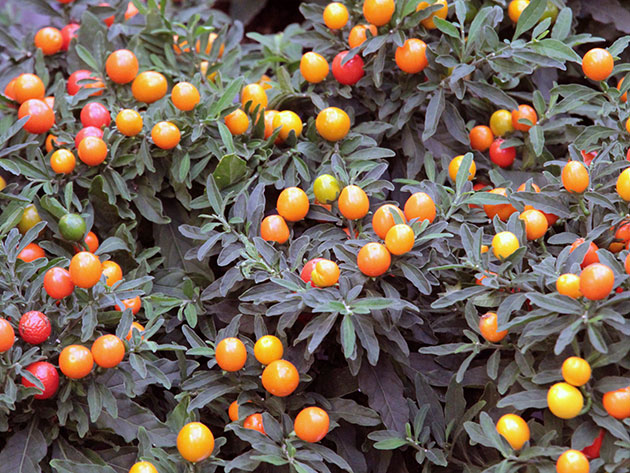
Solanum jasminoides (lat. Solanum jasminoides) - evergreen curly shrub in height from 2 to 4 m with thin and bare twig-shaped shoots, on the upper part of which are entire, simple, bare, oblong-oval leaves, and on the lower part of the shoots, leaves are shiny, sometimes trifoliate, with a larger average share. The light blue flowers of the jasmine-shaped nightshade with a diameter of up to 2 cm are collected in apical paniculate inflorescences. The fruit is a bright red berry with a diameter of about 1.5 cm. Abundant flowering continues from February to October. There are cultural forms of the species with variegated leaves.
Other types of nightshade are grown in culture - Wendland, Giant, Zeafort, Kinky, Pepper, or Pepper, and all of them are highly decorative plants.
Thermophilic nightshade vegetable plants — peppers, eggplants, and tomatoes — are usually grown through seedlings. Before sowing, the seeds are processed from harmful microflora by immersion for 20-30 minutes in a one percent solution of potassium permanganate, and then washed in running water. You can also disinfect the seeds by placing them for 5-10 minutes in a warm (38-45 ºC) two-three percent solution of hydrogen peroxide or soaking them in a solution of trace elements. Some gardeners use stratification of stray seeds for 24 hours in the refrigerator.
It is better to sow seeds with sprouts that do not exceed the length of the seeds - in this case you will be sure of the viability of the seed.
Potatoes are planted with tubers, which are also germinated and disinfected before planting. To learn how to prepare the tubers for planting, read the article posted on our website.
The optimum growth temperature for solanaceous crops such as pepper, tomato and eggplant is 25 ºC. Potatoes are enough for growth and development of 14-18 ºC. At zero temperature, the development of the nightshade stops. As for lighting, solanaceous crops especially need a good light during the seedling period and at the stage of fruit ripening. The lack of light helps to reduce the color intensity and taste of the fruit.
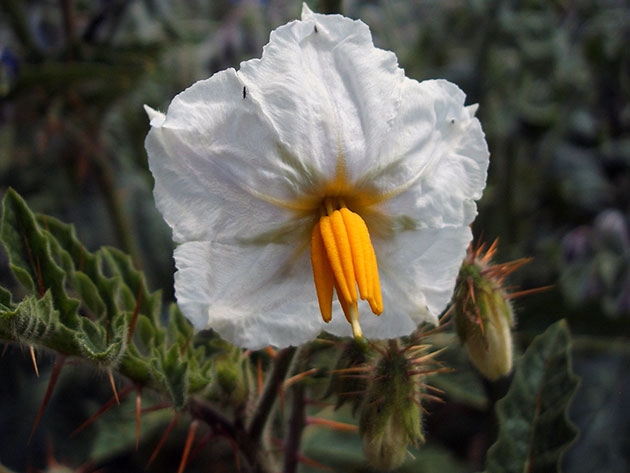
Planted seedlings in areas protected from the wind, warmed by the sun and fertilized with manure a year before planting. The soil is preferred light, loose, warm, permeable to water and air and containing humus. Before planting seedlings dig up the area, fertilizing decomposed compost or humus.
Properties of solanaceous plants
The nightshade family is a large group of plants, including both beautiful flowers and tasty vegetables, as well as medicinal plants. Solanaceous crops are mostly poisonous, which is why people have been wary of eating tomatoes and potatoes for a very long time. Many farmers destroyed the nightshade as a weed, as there were cases of poisoning animals. Because of poisonous substances, tomatoes were once called "cancerous apples", and tobacco is still fought in many countries. Nevertheless, today tomatoes, potatoes, peppers and eggplants are the main vegetables that are included in the daily diet of so many people.
As for the medicinal properties of solanaceous plants, the poisonous alkaloids of the atropine group contained in them can both kill and cure many diseases. Nicotine and anabasin, extracted from tobacco, is used as a narcotic and for the manufacture of insecticides. As skin irritants use bitter peppers, which contains alkaloid-like amide kamsaicin, and glucoalkaloid solanine, which is part of certain types of nightshade, is used as an anti-cough and antirheumatic agent.
4.8 Rating 4.80 (5 vote (s))
Caring for them, protecting them from pests and diseases, if you are my longtime subscriber, - if you first came to visit me, then you are welcome - subscribe to blog updates and immediately get new articles to your email.
All the mentioned cultures are a family of solanas and, in order to broaden the horizons in this topic a little, I suggest you a new article, in which the characteristics of the family will be reviewed, a few photos in which you may see familiar plants, as well as characteristic features which determines the affiliation of the culture to the family of the bouillon.
Short description
The solanaceous family is represented mainly by tropics and subtropics. This large family includes, judging by various data, from 2,200 to 2,500 species and 85 (90) genera.
Among the plants are grasses, shrubs and even small trees with alternate simple leaves. The main representatives of solanaceous tropical countries, especially South America, are trees and shrubs.
The flower of the family is actinomorphic, five-membered, with a calyx that grows only at the base or fused almost along its entire length, with a spinel-like corolla. Androecium flower consist of 5 stamens, pistil Siz two carpels, ovary top. The fruits are represented by juicy berries, like a tomato,
stems, or dry boxes filled with seeds, like in tobacco and petunias.
Where did the name come from
The name of the nightshaped family owes its name to a very large genus - the nightshade, which has more than one hundred species, most of which grow in the New World. Among this family there are species that grow vegetatively in their underground tubers. In the wild state, they grow on scree, where this method of reproduction is very effective.
One of these species is very well known to all of us, one might say, from childhood, and has firmly taken the first place among the crops grown on our land plots. It is tuberiferous morass, better known to all as ordinary potatoes, we also say: "our second bread."

In general, vegetables from the tropics are of the greatest value for us. These include the widely grown tomatoes, eggplants, peppers, as well as Physalis, the already mentioned potatoes and tobacco.
Solanum Exotics
Among the solanaceous plants are present and not very well-known to a wide range of exotic. For example, take Tsifokandru - a perennial lianoid plant with fruits resembling tomatoes. This vine is grown in closed ground. Of no less interest is naranhilla (lulo, lolo, lalo) - a meter bush and more than a height, having huge prickly leaves. The taste of its fruits, they say, is similar to strawberry and pineapple.
Flowers
Such representatives of the solanaceous family, like petunia, are widely known as flower plants.

and varieties of Indian dope with different colors of flowers.
Grass
In our middle latitudes, the nightshade are mainly herbaceous plants. Not very often, but you can also find shrubs (for example, wolfberry). Many from childhood are familiar with the black small berries of black hair.
It grows on littered places and in the garden. Fruits are similar to black currants, they are even edible, but they usually do not eat much, although they are sometimes even used as a filling for pies and a decoration for salads.
Among lovers you can meet those who grow the received the status of cultural stanion Sunberry (Galbri).

The size of the berries of this plant is comparable to the size of cherries - jams are made from them, jam is made.
Indoor culture
At home, sunflowers are cultivated, which is also called Cuban cherry. Despite the attractive name, the red fruits of this plant are inedible. But bowling with a name that says nothing Schultez will delight you with an abundance of edible berries. By the way, it grows not only in the room culture, but also as a wild plant, which is often mistaken for the black hair.
Be carefull! Many solanaceous cultures contain alkaloids, which is why they are poisonous. Datura vulgaris, henbane and belladonna (belladonna) can be attributed to the characteristic representatives of dangerous plants.
be healthy
Vegetable nightshade, the berries of which can be eaten, produce fruits with a very rich and varied chemical composition. they are saturated with starch, various sugars and acids (especially malic and citric), vitamins, salts, and also have a number of other compounds specific for each species.
On my blog you will find more than one article on the agrotechnology of cultivation, biology, care and useful properties of the most common and most beloved crops from the family of the nightshade - tomatoes, pepper, eggplant. There are recommendations on the cultivation of at least less common, but no less interesting promising crops - Physalis and.
I sincerely hope that the article was useful to you, my dear readers! See you!
With all respect, Andrew!
Enter your e-mail and get new articles in the mail:

Solanaceous (lat. Solanaceae) - a family of spineolepalous plants of the class dicotted Grasses, less often shrubs, creepers and small trees. Over 2500 species (about 90 genera), in temperate, tropical and subtropical zones (mostly in South and Central America). The most important childbirth: nightshade, tobacco, mandrake. Many are valuable food (potatoes, tomatoes), medicinal (belladonna, henbane, scopolia, etc.), cultivated (tobacco), ornamental (petunia) plants, although there are also poisonous representatives, for example, dope.
Nightshade (Solanum), a genus of grasses, shrubs and dwarf shrubs (rarely trees) of the nightshade family. About 1,700 species, are widely distributed, most - in South America. The genus Nightshade includes potatoes and eggplant. Some Nightshade are poisonous. There are medicinal - bitter sweet nightshade (Solanum dulcamara).
Mandragora (Mandragora), a genus (5-6 species) of plants of the family Solanaceae (Solanaceae). For the most part - large perennial grasses, as a rule, always stemless with large leaves collected in a rosette - up to 1-2 meters in diameter, common in the Mediterranean, Front and Central Asia, the Himalayas. However, some types of mandrake - Mandragora stem (Mandragora caulescens) has a developed stem, and Mandragora Tibetan (Mandragora tibetica) - unlike other species - small, inconspicuous plant.
Scopolia, a genus of perennial herbs of the family Solanaceae. 4-6 species in the temperate zone of Eurasia. In Russia, in the North Caucasus, there is one species - scoliopium karnioli, medicinal (contains alkaloids scopolamine, atropine, etc.) and an ornamental plant.
Belladonna, a perennial herb of the genus belladonna family of the nightshade. Height 0.6-2 m. Grows in Central and Southern Europe, Asia Minor, the Caucasus, the Crimea and the Carpathians; in culture as medicinal. It is used as an analgesic, antispasmodic. It is poisonous. Belladonna contains atropine, which dilates the pupils, and therefore women in ancient Rome used it as a “means of beauty”. Hence the name belladonna (Italian. Belladonna - beautiful lady).
Helena, a genus of one- and two-year grasses of the family of the nightshade. About 20 species in Eurasia, Africa and the Canary Islands. Helen black poisonous; weed. Leaf extract is used in medicine (antispasmodic, analgesic).
Pepper vegetable (Capsicum), a genus of shrubs, dwarf shrubs or perennial herbs of the family Solanaceae. About 20 species, mainly in Central and South America. Many species of this genus are grown, but the most common in the countries of the tropics, subtropics and temperate zones is the vegetable pepper, or paprika (Capsicum annuum), an annual self-pollinating plant. Stem up to 1 m high, woody at the base, leaves ovate-lanceolate. The flowers are yellowish or purple, bisexual. The fruit is a pod. Weight from 0.5 to 200 g, length from 1 to 20 cm. Mature fruits are red, orange-red or yellow. Form - from elongated to spherical. The homeland of the pepper is Central and South America (southern Mexico, Guatemala), where it was introduced into culture long before n. er Columbus was brought to Europe in 1493. From Spain and Portugal quickly spread throughout Europe, and from the Balkan Peninsula to Africa and Asian countries. Cultivated as sweet varieties and varieties, and bitter (sharp), which are used as a spice. In Russia, peppers imported from Persia and Turkey have been cultivated since the 17th century. In the south, it is grown in open ground, in the central and north-western regions - in the protected.
Datura, a genus of grasses, less often shrubs or trees of the family of the nightshade. Over 10 species, mainly in the tropics and subtropics. Datura ordinary, common in temperate and warm belts of Eurasia, is a poisonous medicinal plant (leaves are part of anti-asthma drugs, atropine is obtained from seeds); cultivated in a number of countries.
Petunia, a genus of one and perennial grasses of the family Solanaceae. About 15 species in America. Numerous varieties of hybrid petunias are cultivated as decorative. Physalis is a genus of one and perennial grasses of the family of the nightshade. Over 100 species. Physalis is Peruvian, physalis is pubescent, gluten-fruit fizelalis and others are vegetable crops (sweet fruits with strawberry flavor), in Asia, North and South America, Africa, Europe. Physalis, vegetable and ornamental plant. The peculiarity of Physalis is the presence of a swollen lantern cup closing the fruit-berry. In the wild form is found in Mexico and Guatemala, where it was introduced into the culture long before our era.
Botanical description. Grasses, upright or creeping shrubs, and occasionally small trees (Solanum, Dunalia and Acnistus spp.); leaves in solanaceous whole, toothed, lobed or incised; in the vegetative part of the stem they are alternately arranged, and in the flower-bearing one - in pairs (usually 1 large leaf and 1 small); paired leaf arrangement due to sympodial branching and joint displacement of parts; As a result, in some of the Solanaceae (Datura, Physalis, Solanum), the stems appear dichotomous or trichotomically branched, the branches go not from the sinuses, but the flowers or inflorescences are seated at the fork of the branches. The flowers are collected in inflorescences, curls, without bracts. Flowers bisexual, rarely completely correct. The fruit is a berry or a box that opens through the sash or cap. The seeds are more or less reniform, containing fleshy protein, mostly curved embryo.
The most interesting genera of the Solanaceae family:
Helena (Hyoscyamus)
Brugmansia (Brugmansia)
Dereza (Lycium)
Datura (Datura)
Calibrachoa (Calibrachoa)
Belle (Atropa)
Mandragora
Nicandra
Solanum (Solanum)
Pepper (Capsicum)
Petunia (Petunia)
Scopolia (Scopolia)
Solandra
Tobacco (Nicotiana)
Tomato (Lycopersicon)
Physalis (Physalis)
Healing properties and application in traditional medicine. Mandragora officinalis (Mandragora officinalis) - the most famous plant of this genus. Distributed in the Mediterranean region. Large, starch-rich roots sometimes resemble the shape of a human figure, in connection with which in ancient times they attributed magical properties - healing from ailments, facilitating conception and the ability to bring happiness in lawsuits. In the old days, a mandrake root was cut out of the so-called Adam's head, which was worn as an amulet, bringing happiness, driving away diseases. Various legends about treasures, fortune-telling, etc. were associated with it, as with the plant itself. The mandrake root in antiquity was used before difficult operations. The plant is poisonous, its extract, even in the smallest doses, causes drowsiness in animals and people, and in large doses it acts in an exciting way on the nervous system. The leaves are used as a pain killer - they are applied to the wounds, some people smoke them like tobacco. The fruits of mandrake were used by the Arabs as a sleeping pill, they were also credited with the ability to initiate sexual activity and they made love drinks from them. On the territory of Turkmenistan grows species - Mandragora Turkmen (Mandragora turkomanica) - endemic, threatened with extinction. Listed in the Red Book. This is a large stemless plant with broad oval or ovate leaves, collected in a rosette up to 160 cm in diameter. The roots penetrate to a depth of 2 m. The flowers are pollinated by various insects. Fruits are large, 5-6 cm in diameter, orange, fragrant, edible. Mandrake root contains a number of substances - hyoscin, hyoscyamine, atropine, myristic acid, phytosterol. Pepper Juicy, fleshy sweet pepper fruits have high palatability, contain large amounts of vitamin C - up to 300 mg per 100 g of fresh fruit weight (more than any other vegetables), vitamin P, group B, carotene (especially many in red fruits), salts of potassium, sodium, calcium, iron, essential oil, giving pepper a peculiar smell. The hotness of hot pepper pods is caused by the content of the capsaicin alkaloid that accumulates in the fruit as it ripens. The content of capsaicin is especially high in the so-called Kabensky pepper, referred to as a shrub pepper (C. frutescens) or isolated into a separate species. Sweet pepper is consumed fresh and after cooking, canned (while it retains up to 70% of vitamin C), and freeze. Hot pepper is a hot seasoning (liquid or powdered), an important component of adzhika, chili and other sauces. ; tincture of hot pepper is used for radiculitis, vodka pepper tincture is an anti-cough agent, it also has a disinfecting effect for intestinal infections. Hot pepper is used to make a pepper patch.
LESSON - PORTFOLIOTHEME: Family of the nightshade. Common signs of solanaceae. The purpose of the lesson: continue to form an idea of the diversity of flowering plants Tasks of the lesson:
Educational:introduce the plant features
family Solanova, their diversity and the use of plants
a man;
Corrective-developing: learn to analyze, compare, summarize,
highlight the most important, independently draw conclusions. Develop ability
reproduce the material being studied.
Educational: foster interest in the subject, foster intolerance to
bad habits. Vocabulary: solanaceous, portfolio, technical cultures, dope, henbane, petunia, fragrant tobacco.
Equipment: computer, multimedia installation, presentation in Power Point, signal cards, memos, a set of pictures of plants of different families, cards with signs of monocotyledons and dicots, fruit models.
During the classes: 1. Organizational moment
1) Greeting:Good afternoon guys.
The bell rang and fell silent.
The lesson begins.
Everyone looked at me
Smiled and sat down quietly. - May you be accompanied by a good mood during the whole lesson and help you successfully cope with the tasks.
2) Target installation: - Today in the classroom we will continue our acquaintance with flowering plants; - we will learn to identify common signs of plants that are combined into one family; - to find signs of the class of dicotyledons in plants.
Ii. Homework check - Remember what two groups are divided flowering plants? ( Flowering plants are divided into monocots and dicots)1. Distribute the signs of monocotyledonous and dicotyledonous plants.
There are cards on the board on which signs of monocotyledonous and dicotyledonous plants are written. The student distributes the cards with signs, pronouncing them.
Monocotyledons Dicotyledons
in seed 1 cotyledon in seed two cotyledons
gummy root system core root system
arc and parallel net venation of leaves
2. What class of plants are we currently studying? (class dicotyledonous) 3. What family from this class did we meet in previous lessons? ( rosaceae family)4. Name the plants belonging to the family Rosaceae. (Apple, pear, plum, cherry, wild rose, rose, silverweed, sabelnik, strawberries)
5. Give examples of plants whose fruits are eaten ( apple, pear, strawberry, raspberry, cherry, etc.)7. Give examples of plants used in medicine ( hawthorn, sabelnik, wild rose, rowan, bird cherry8. Name the floral - ornamental plant of the Rosaceae family ( the Rose)
III. Updating reference knowledge
To find out what family we will meet in class, we need to solve a crossword puzzle.
|
1. Though the sun burns him, he is dressed in the bottom, |
|
2. I am called the queen of flowers. I look beautiful, gentle, |
|
3. On the bitch hanging balls turned blue from the heat. (Plum) |
|
4. I did not live in the bug bug, and did not eat the worm, |
|
5. On a forest clearing - Red Maid. To see her, We must bow (Strawberry) |
|
6. Live a useful shrub |
|
7. Round, ruddy Adults love me And little kids. (An Apple) |
|
8. Dolgon praises: Am I not a beauty? |
|
9. Bells appeared - white peas, |
|
10. A tree with snow-white odorous flowers and the knitting fruits. (Bird cherry) |
(Slide 2)
Tell me why the word lily of the valley is written in a crossword puzzle with letters of a different color? (because it does not belong to the family Rosaceae)- Read the word vertically and you will find out what family we will meet in class. ( Solanaceae) - Right, guys. Today at the lesson we will get acquainted with the family of the nightshade, learn its common features, get to know the representatives of the plants of the nightshade family.
Iv. Learning new material
Theme of the lesson: “The family of cedar. General signs of solanas. " (Slide 3)
- Write the topic of the lesson in the notebook. Our lesson is called lesson - portfolio. What is a portfolio? (SLIDE 4) - This is the most different information collected about someone. For example, a student's portfolio contains information about performance, participation in sports competitions, contests, competitions and other differences among schoolchildren. In the lesson, we will put together a portfolio of the mother's family. - What should a portfolio contain? First of all, information about the distinctive features of the plants of this family. On the table of each of you are reminders, they indicate the signs of the family, which we will pay attention today, getting acquainted with the nightshade. ( The students on the desk are memo) Portfolio family solanaceous (Slide 5)
Family name
Life forms of plants of this family
Features of the structure of the flower and inflorescence
Types of fruits
Features of the structure of the root system, stem, leaves
Representatives of the family, their use by man
We are starting to collect the portfolio of the nightshade family.
We already know the name of the family . (the teacher puts the first page of the portfolio on the board). Annex 1 (Slide 6) Planan family came to us from South America. There are about 3,000 plant species. Life forms solanaceae varied. Most of the plants are grassy, although there are shrubs and even trees in their homeland. ( the teacher puts the second page of the portfolio on the board). Appendix 2 - From what plant did it get the name of this family? ( Nightshade) (Slide 7)- Do you know this plant? Where did you meet him? ( it can be found in the gardens, in the field)- Have you tried the berries of the nightshade? What do they taste like? - Nightshade is often called a late summer, because it is only at the end of the summer that black berries ripen. Since ancient times, the nightshade has been used for medicinal purposes. Its fresh fruits and leaf juice were used to treat the digestive and circulatory organs. But black hairy is a very dangerous plant. It contains a substance that causes poisoning in animals and humans. Therefore, it is possible to eat only the ripe fruit of the black hair. In addition to the nightshade, this family includes: Potatoes (Slide 8)Tomato (Slide 9)Pepper (SLIDE 10)Eggplant (SLIDE 11) Why are these plants combined into one group? On what basis are plants combined into a family? ( flower structure, fruit) Introduction to the structure of the flower ( according to verbal instructions) (Slide 12)
a) Consider the scheme of the hairy flower. Find the cup, whisk, stamens and pistil.
b) Count the number of sepals, corolla petals, stamens and pistils. Write the flower formula in the notebook.
c) Tell us about the structure of the flower of the nightshade using the picture.
(In flower five sepals, five petals of corolla, five stamens, one pistil)
g ) collect the flower formula on the board ( the student collects the flower formula from the cards)
H (5) B (5) T5 P 1
In the family of the nightshade there are plants with small flowers, gathered in inflorescences (nightshade, henbane, potatoes) (SLIDE 13)
Not uncommon and large, single flowers (petunia, dope) (SLIDE 14)
(the teacher puts the third page of the portfolio on the board). Appendix 3
What fruits are found in Solanaceae ? (berry, box) (SLIDE 15) , (Slide 16)
Seed consists of two cotyledons
(the teacher puts the fourth page of the portfolio on the board) Appendix 4
(SLIDE 17)Features of the structure of the root system, stem, leaves:
8) what is the root system of the nightshade ( pivotal)
9) The stem of the Solanaceae ... ( erect)
9) What are the leaves of the nightshaft? ( simple, with a vein reticulation)
(the teacher puts the fifth page of the portfolio on the board). Appendix 5
Why, then, did the plants under consideration combine the nightshade into one group?
Conclusion: the studied plants belong to the nightshade, as they have similar characteristics.
1. Primary consolidation of knowledge. (Work with the textbook)
Based on the table, tell us about the signs of solanaceous plants
Signs of bouillon
|
Root system |
pivotal |
|
Erect |
|
|
Simple, with mesh venation |
|
|
Inflorescence |
Single flowers, brush |
|
5 petals, 5 stamens, 1 pistil |
|
|
Boll or berry |
|
|
two cotyledons |
Tell me, why do these broths belong to the dicotyledon class?
Conclusion: solanaceous plants are dicotyledonous, since they have a taproot root system, a net veining of leaves, the seed contains two cotyledons.
PHYSICAL TRAIN:
Head tilts backwards;
Head turns left, right;
Swing his left hand over his right shoulder, his head to turn left, and vice versa ...
Blink your eyes quickly, close your eyes and count to five;
Circular eye movements first to the right, then left 2-3 times in each direction and looked into the distance.
(Slide 18)- What cultures are depicted on the slide?
Why do people grow these crops? ( in food)
What word can be called plants depicted on the screen? (vegetable)
What are the benefits of vegetables?
Right. They contain a large amount of substances useful to humans.
The guys have prepared for us information about the benefits of vegetable plants for humans. ( the message of additional material by students)
1. Potatoes. Potato tubers are not only nutritious, but also healing. They contain a large amount of mineral salts that contribute to the elimination of water and salt from the body. Starch gives energy to our body.
2. Tomato (tomato)contains many nutrients: vitamins and mineral salts, as well as carotene. This is a low-calorie diet product that has excellent taste. Vitamins C and A, which are contained in the fruits of tomato, strengthen the body's immunity and help to resist various diseases. Special substances in tomatoes improve mood. Eat tomatoes and you will always be cheerful and cheerful!
3. Eggplant useful for people with diseases of the heart and blood vessels, prone to the accumulation of overweight and obesity. Eggplant fruits reduce blood sugar levels, which means they are useful for people with diabetes. They help the formation of red blood cells, so they are recommended for people suffering from anemia (anemia).
4. Pepper - the undisputed leader in the content of vitamin C. Mature red pepper contains six times more vitamin C than lemon. A small slice of pepper will satisfy the adult's daily need for ascorbic acid. Bulgarian pepper is rich in vitamin A (it is more there than in carrots), which is known to stimulate the growth of hair and nails, has a beneficial effect on the skin, slows the aging process. It is especially important to use sweet pepper during the period of active growth, as vitamin A is involved in the formation of teeth and bones. Pepper should be eaten by people prone to bad mood. It is useful for people with heart disease, liver, for those who have low blood pressure.
In addition to vegetable plants in the family there are medicinal plants, flower and decorative. (Slide 19)
- Make a diagram from the slide in the notebook . (students work in notebooks)
- Let's get acquainted closer with medicinal and flower - ornamental plants of the family of the nightshade. To medicinal plants include dope and henbane . Plants are poisonous. All parts of plants are poisonous. (SLIDE 20)
Henbanegrows along roadsides, in wastelands, in courtyards and in vegetable gardens, that is, it is found not far from the places where people live. Dirty yellow flowers with purple streaks. During flowering from the plant is a rather unpleasant smell. Even animals that have a much more sensitive sense of smell, bypass the bleached side. The fruit is a box, the seeds in appearance resemble poppy, small, dark brown, appear at the end of summer. Helen is a very poisonous plant, and all parts of the plant are poisonous, especially the seeds. The most affected children are those who confuse henbane seeds with edible seeds. Symptoms of poisoning (confusion, fever, palpitations, dry mouth, blurred vision, etc.) appear after 15–20 minutes.
Dope Flowers emit a strong heady smell. Toxic substances are found in fruits and seeds. Plants are used in medicine.
Preparations from these plants have a calming effect on the central nervous system, have an analgesic effect.
Poisonous plant is tobacco. (SLIDE 21)
What do people make of tobacco? ( cigarettes)
What poisonous substance do they contain? ( they contain the substance - nicotine)
People who use tobacco develop such diseases as cancer, they suffer from memory and attention.
(Slide 22) Mathematicians have calculated ...
- each smoked cigarette shortens life by 15 minutes;
Every 13 seconds, a person dies from a disease associated with smoking;
For the year - this is 2.5 million people:
Approximately 1.1 billion people in the world are smokers.
This problem also touched our school ... (school statistics: the teacher gives the data of the survey to identify children with a bad habit)
Flower and ornamental plants:petunia, fragrant tobacco (SLIDE 23)
Why grow flower - decorative crops? ( for beauty)
They delight people with beautiful flowers and a unique delicate aroma.
(SLIDE 24)
We met with representatives of the family
(teacher places sixth page portfolio on the board) Appendix 6
We will talk about many plants with which we met in the lesson in subsequent classes, learn to grow some of them, sow flower seeds and grow flower seedlings for the school site. We will complete the portfolio with interesting materials.
V. Anchoring:
Match the name of plants and their images. (Slide 25)
You have cards on the table with the letters A, B, C, D, E, E, which you can use. I call the plant, and you show the letter under which it is depicted.
- What family are the depicted plants? ( solanaceous)
Work with models. Get out of the vase only those fruits that belong to the plants of the nightshaft family ( assignment for a weak student body)
Put the plants on the cards into groups. (each child on the desk has a set of cards with images of plants from the family of the nightshade and rosaceae: henbane, potatoes, strawberries, eggplant, pear, apple, petunia, tomato, dope)
How many groups have you got? (two)
What are the families of plants depicted on the cards? ( solanaceous and Rosaceae)
What class are these families? ( to class dicotyledonous)
VI. Total:
How does a man use plants of the nightshaft? (eats, makes medicines, decorates its dwellings).
Evaluating children.
Reflection (SLIDE 26)
Complete the sentences you see on the screen:
Today in class I ...
The most interesting for me ...
Lesson to me ...
Tomato, pepper, eggplant, potato - these plants have long been known for their economic importance. All of them belong to the family Pasanova. The formula of the flower, the type of fruit, life form - these are the signs by which you can combine the presented plants. Our article is devoted to the characteristics and diversity of representatives of this systematic unit.
Signs of the Solanaceae family
All members of this group growing in the temperate climate zone are exclusively herbaceous plants. But in Central and South America there are lianas, shrubs, and trees. The signs of the family Solanaceae also include simple leaves with the next arrangement. According to the shape of the plate, they can be solid, notched, serrated.
Parts of some plants are covered with glandular cells. Their discharge has a peculiar smell. Datura and henbane accumulate in their tissues toxic substances, which are called alkaloids.
Family Solanaceae: Flower Formula
Did you know that there are formulas in biology too? For example, H (5) L (5) T5 P1. And it is also a systematic feature of the Bean Family. The formula of a flower is very easy to decipher.
The first two letters and numbers characterize the structure of the perianth. H (5) - the number of sepals, and L (5) - petals. The latter grow together with each other, so they visually resemble a straw. T5 - the number of stamens. The representatives of the family all grow together with the corolla. And, it's easy to guess, P1 is the only pestle.
Such flowers can be single or collected in inflorescences, like in potatoes. Most often they are pollinated by insects. Their attention is attracted by the aroma and bright halo. In the tropics, birds and mammals also take part in the pollination process.
Solanaceae form fruits of two types: berry and box. The first has a dense protective skin, fleshy middle and inner layers, contains many seeds. Berries are formed in the process of pollination of flowers of tomatoes, peppers, potatoes and eggplant. A boll is a dry, multi-seeded fruit. It can be revealed in different ways. For example, the dope has numerous longitudinal slots, while a henbane has a lid on it.

Diversity
In addition to well-known vegetable crops, such as peppers and potatoes, the Solanaceae family includes ornamental species. This physalis, petunia, fragrant tobacco. They are valued for the bright color of the rims and the pleasant aroma.
Medicinal plants are black nightshade, bittersweet, pepper-shaped. They are used in the treatment of rheumatism, depriving, of psoriasis, as an expectorant. Belladonna is also famous for its healing properties. The leaves of this plant have long been used for the manufacture of drugs that reduce muscle tone.
Helen, which is considered a poisonous plant, is widely used in medicine as a painkiller, expectorant. The herb also has a relaxing effect on the nervous system.

The typical structure of the family Solanaceae has mandrake. During the Middle Ages, she was attributed witchcraft properties, so they called it a witch or sorcerer flower. The root of this plant visually resembles a human figure. The escape is devoid of a stalk. It consists of leaves and large single flowers with a bright corolla.
Such an unusual structure determined the use of mandrake for magical purposes as a means of quivering, getting rid of infertility and many ailments. It is known that in ancient Greece the flowers of this plant were worn around the neck as an ornament and amulet of love.
In fact, the mandrake is very poisonous. It can both initiate and inhibit the activity of the nervous system, cause insomnia and even hallucinations.
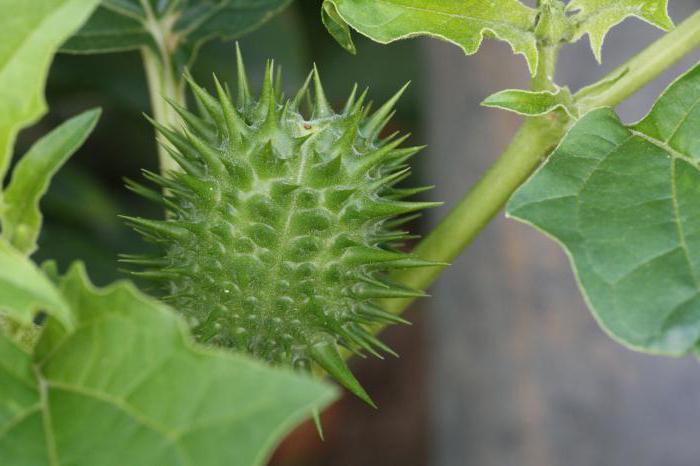
Economic value of plants
But the main importance still have vegetable Solanaceae. Can you imagine your diet without potatoes? Surely not. But for a long time this plant was considered poisonous. And all because people used to eat its fruits, which are really inedible. Application found only inflorescences of potatoes, which decorated clothes, hats and hairstyles. Today, a person eats an underground modification of a shoot as food - tubers.
So, in our article, we examined the following features of the Pasanow family:
- flower formula H (5) L (5) T5 P1;
- corolla formed by fused petals;
- life forms - grass, less often - shrubs, creepers and trees;
- leaves are simple;
- the fruit is a berry or a box.

